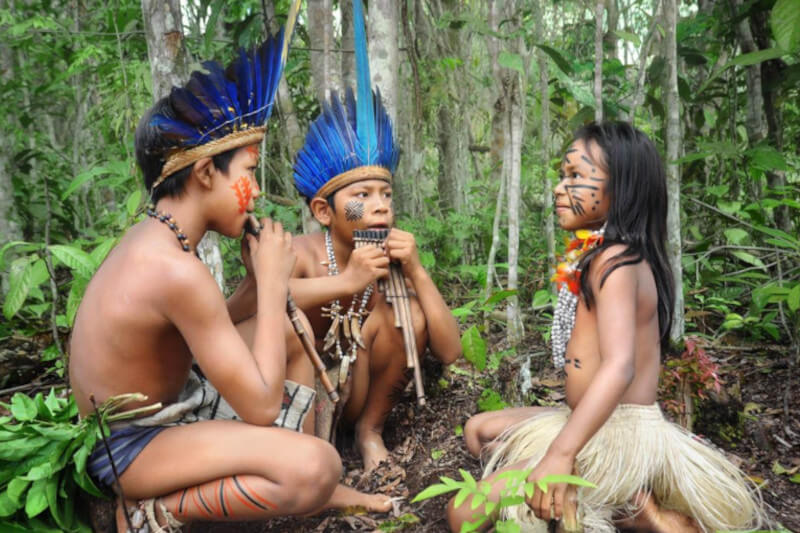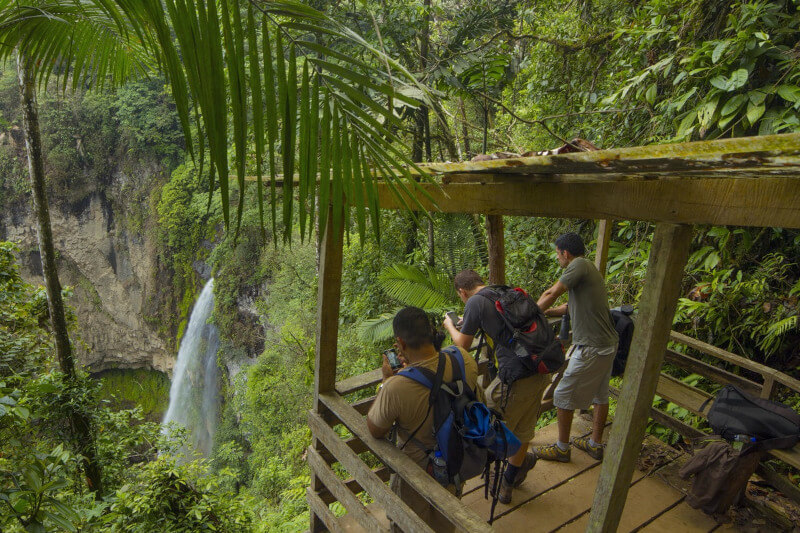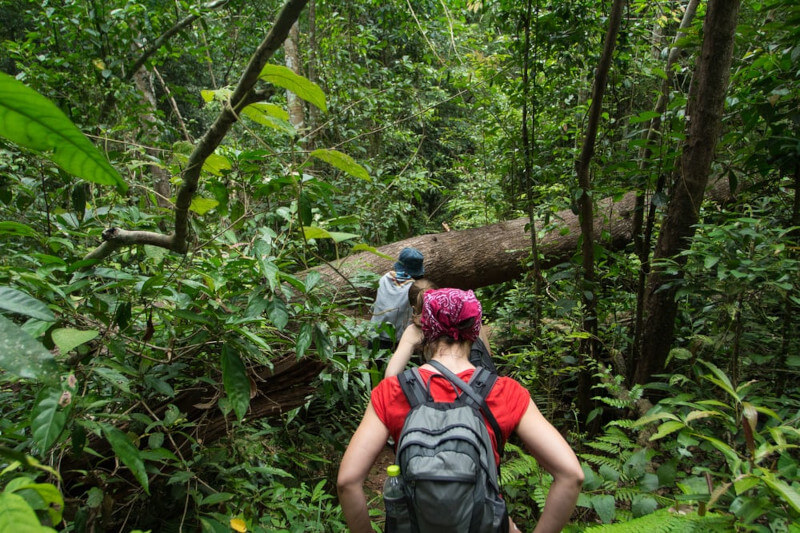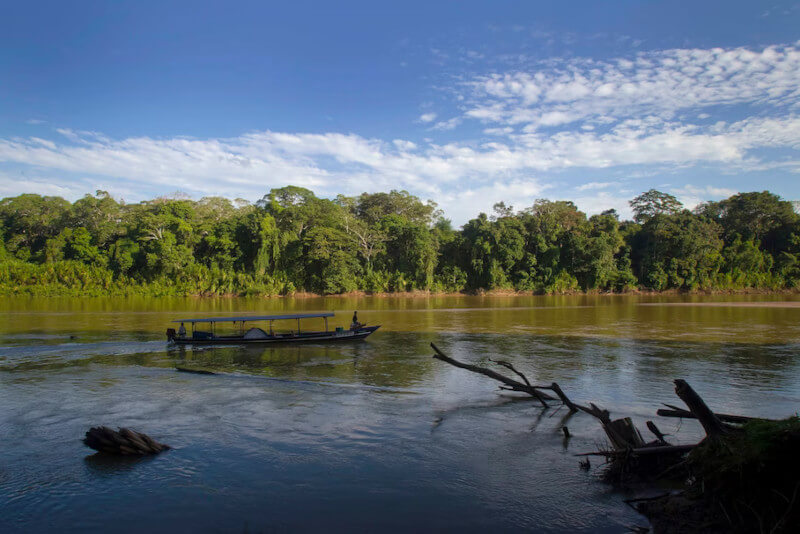The Peruvian Amazon Basin is a place where the vibrant tapestry of life unfolds in the most spectacular fashion. With its dense rainforests, winding rivers, and rich biodiversity, it is a destination that promises an unforgettable adventure. As travelers, we must make sure our journeys are memorable while also being respectful to the environment and local cultures.
In this article, we will discuss how to experience sustainable tourism in Peru’s Amazon Basin, focusing on essential activities and responsible practices.

The Amazon River in Peru is a vast waterway flowing through the dense rainforest, nourishing one of the planet’s most biodiverse areas. The sheer size and beauty of the Amazon rainforest make it a must-visit for any traveler seeking to immerse themselves in nature.
The Amazon River is not just a river; it’s an ecosystem teeming with life. Amazon River house a wide variety of aquatic life, including the well-known pink river dolphin and the fearsome caiman. The river is a vital artery of the rainforest, supporting both wildlife and human communities. Exploring its waters offers a unique perspective on the interconnectedness of life in the Amazon.
The Amazon rainforest is home to countless species of plants and animals, many of which are not found anywhere else in the world. From the vibrant feathers of macaws to the elusive jaguar, the Peruvian Amazon offers a chance to witness wildlife in its natural habitat. Birdwatchers and nature enthusiasts will find themselves in paradise, as the region is renowned for its remarkable variety of bird species.
The Peruvian Amazon is not only a haven for wildlife; it is also home to numerous indigenous communities. These communities have lived in harmony with the rainforest for centuries, and their cultures and traditions are a vital part of the region’s identity. Engaging with these communities offers a unique opportunity to learn about their way of life and gain insights into their relationship with the land.

As more travelers seek to explore the Amazon, it becomes crucial to practice sustainable tourism. This means making choices that minimize environmental impact and support local communities.
When planning your trip, consider staying in eco-lodges that prioritize sustainability. These accommodations are designed to have minimal impact on the environment while providing guests with a comfortable and immersive experience. Many eco-lodges in the Peruvian Amazon are located deep within the rainforest, offering a chance to wake up to the sounds of the jungle.
One of the key principles of sustainable tourism is supporting local economies. When visiting the Amazon, choose tours and activities that are operated by local guides. This not only provides you with a more authentic experience but also ensures that your travel dollars benefit the communities you visit.
Respect for the environment and cultural heritage is essential when traveling in the Amazon. Follow Leave No Trace principles by minimizing waste and avoiding activities that could harm wildlife or ecosystems. Additionally, be mindful of the cultural norms and traditions of the indigenous communities, and always seek permission before taking photographs.

The Peruvian Amazon offers a wealth of experiences that are both exhilarating and educational. Here are some highlights to consider for your journey.
Cruising along the Amazon River allows you to witness the majesty of the rainforest from a unique vantage point. Many riverboat tours offer guided excursions that take you deep into the heart of the jungle, where you can spot pink river dolphins, caimans, and an array of bird species. These journeys often include visits to remote villages, providing a glimpse into the daily lives of the people who call the Amazon home.
Exploring the rainforest on foot with an experienced guide is an opportunity to connect with nature in a profound way. Guides offer invaluable knowledge about the flora and fauna, as well as the medicinal plants used by indigenous communities. These hikes are a chance to discover hidden waterfalls, observe wildlife up close, and experience the tranquility of the jungle.
Participating in conservation projects is a rewarding way to give back to the environment. Many organizations in the Peruvian Amazon offer volunteer programs that focus on wildlife research, habitat restoration, and community development. By contributing your time and skills, you can make a positive impact while gaining a deeper understanding of the challenges facing the rainforest.

To make the most of your trip to the Peruvian Amazon, careful planning is essential. Consider the following tips to ensure a seamless and enriching experience.
The Amazon experiences two main seasons: the high water season (December to May) and the low water season (June to November). Each season offers distinct advantages, so consider your interests when planning your visit. The high water season allows for easier river navigation, while the low water season provides better opportunities for hiking and wildlife spotting.
Before traveling to the Amazon, consult with a healthcare professional about necessary vaccinations and medications. Malaria and yellow fever are present in some areas, so taking preventive measures is important. Additionally, pack insect repellent, sunscreen, and lightweight clothing to protect against the elements.
Reaching the Peruvian Amazon typically involves a flight to Iquitos or Puerto Maldonado, followed by a riverboat or overland journey to your destination. Many eco-lodges and tour operators offer packages that include transportation, accommodation, and guided activities, making the logistics of your trip more manageable.
However, Manu National Park is the only Amazon region that can be easily reached from Cusco.

Sustainable tourism in Peru’s Amazon Basin offers a chance to explore one of the world’s most extraordinary natural wonders while contributing to the preservation of its unique ecosystems and cultures. By making responsible choices and embracing meaningful experiences, you can embark on a journey that is both memorable and impactful.
Whether you’re a travel blogger crafting captivating narratives, a travel agency owner curating unique experiences, or a history and culture enthusiast seeking enrichment, the Peruvian Amazon invites you to discover its magic in a way that honors its beauty and legacy.
If you got any questions, please do not hesitate to send us a message. We reply within 24 hours!
+51 900 394 399
info@biomanuexpeditions.com
reservas@biomanuexpeditions.com
